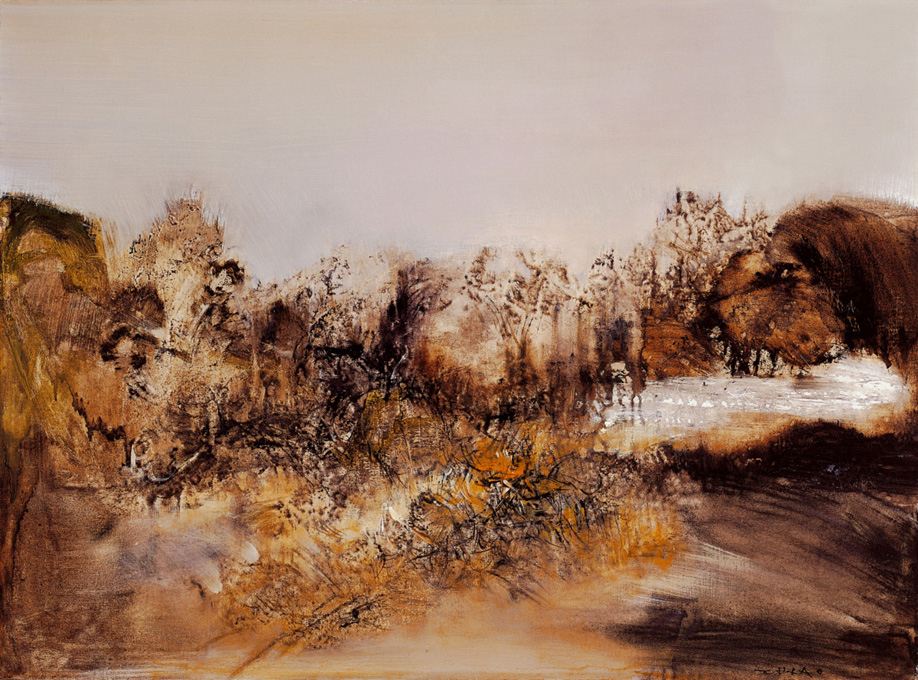|
20. 10. 69
|
|
1969 Oil on canvas 60 x 81 cm Signed lower right Wou-ki in Chinese and ZAO in French On the reverse |
|
Estimate
15,000,000 - 20,000,000 3,571,400 - 4,761,900 457,300 - 609,800
|
|
Sold Price
16,840,000 3,982,029 509,917
|
|
|
In 1970, Zao Wou-ki's first autobiography published in France, it indicates that the artist's accomplishment was generally acknowledged by then. Before that, French television station had just produced and broadcasted a special series of Zao's art in 1969. Earlier, He was invited by Japan National Museum of Contemporary Art for exhibition, held his second retrospective exhibition in his life in Musée d'Art Contemporain, Montreal, there were as well countless invitations from all over the world. Zao thinks that his paintings created during 1960-1970 have received fruitful results. Many art critics also praised his abstract paintings from that period; he acquired enormous fame that he had never expected during that time.
French art critic Jean Leymarie once point ed out : "Son art necesse de s'épanouir sur ses fondements, au niveau des rythmes, des textures, des modulations colorées, par contraste ou synchronisation de variables toujours ouvertes. Il ya des toiles plutôt monochromes, tantôt sombres et chargées, lavis brun aux griffures noires, tantôt opalescentes et légères, brumes de cendre et d'argent, d'autres aux accords somptueux de neige et de saphir, de mousse et de rubis..." (Jean Leymarie, Zao Wou-ki, Edition Cercle d'Art, Paris, 1986, p. 40) Leymarie had pointed out one of the distinguishing features in Zao's paintings – color. Indeed, there is a base color in every peices of wrok, none of these colors were taken from pigment, the are scales within similiar colors, the way he applies the colors on the on the canvas is also delightful. Taiwan art critic Chu Ko thinks Zao "refined oil into medial ink, it is an achievement that is unrivaled by any of those western painters." also praised "Zao's using the color is philosophical, rich in colors but could not be realized by ink." (Chu Ko, The Truth of Nature, compiled by Yuan Te-hsing, Zao Wou-ki, Yuan-Chen publications, Taipei, 1980, p. 9)
French art historian René de Solier once asked Zao about his taste on colors, Zao answered: "I like all kind of colors!" Solier followed "Which of them is the base color?" "None, I have no preference on colors, I have better reception on trembles." This shor t conversat ion explained Zao's secret in his paintings. Colors aren't necessary to be the subject in his paintings, trembles of lights are, he has more concern on the space inside the picture. Trembling lights and colors established the look of Zao's lyrical and abstract paintings during the 60's. Traditional Chinese landscape paintings possessed above features, and Zao not only is conscious of the essences in eastern paintings, but also carries the influences from Paris classical paintings as well as contemporary abstracts, therefore he said other artists learned one tradition by heart, he learned two.
Taiwanes are critic Hsiao Chiung-jui sees Zao's paintings in an emotional point of view; he thinks that Zao's works is a record of rise and fall in life, and various emotional changes from living. He pointed out that Zao's works during the '60s features "lines as thin as fibers". Although he suffered from depression, fear and emotional entanglements, his paintings remain harmonic, uplifting, unrestrained and rising. "Sienna is the base color in his works from the '60s, they shines golden bronze flames, exquisite, sharp and paranoid fiber-like lines freely splashed, combines in the picture following his heart, he got rid of restrains of themes and rules . Zao Wou-ki presented a deep, dynamic, and glorious world of wilderness."(Masters of Chinese Painting: Zao Wou-ki, Chin Hsiu Publications, Taipei, 1992, p. 18) The frustrations from working in a foreign land, depressions, and endurances in life was hard to express. Only when facing the canvas in his studio he could talk freely to his art. Therefore Zao's 60's paintings were full of strong and intense emotions with great philosophies withon.
His old classmate Wu Guanzhong once said, Zao Wou-ki's abstract paintings was like a wing spread Kun-Peng to him, that is an illusion when a shooting star across the sky. "...the older, the wiser, Zao's pictures turned to be spicy around 1970. there are bizarre lights penetrates through thickness and richness, wandering into giant's footsteps......" (Wu Guanzhong, Zao Wou-ki's paintings, Memories of Wu Guanzhong, WanXiang publishing, Taipei, 1st edition Mar. 1992, p. 223) Chu Ko thought about field pleasures in the wilderness when he looked at Zao's paintings, there are also two dimentional spaces like sculptures of flowers overlaid on the forest. "All I can see in his pictures are: wilderness and loneliness, rivers, oceans and waves, springs flowing, grasses waving up and down, mosses on rocks, mottled rocks, spring flowers turning purple, and golden sunshine, nature is everywhere in his paint ings" (Chu Ko, The Truth of Nature) Zao combined the essences from eastern and western arts, In the eyes of no matter eastern or western critics, his paintings is unique and extraordinary. As a forld famed artist, his success is never by chance or accidental.
"20.10.69" inherited the lights, flames and mystery that only can be found in his '60s works, it's also the opener for the strong images in his '70s paintings, beige is the base color in this painting, and is a colorful one with strong brush strokes, it's a very kinematic piece of work. All the layers in the pictures are graceful and delicate, as if winds are flowing; the light yellows and snow whites decorated in the picture added a sense of beauty and bravery. Especially that color in a silverwhite tone at the top of the picture is as glossy as crystals and china, as bright as starry nights, the whole picture is full of the artist's exquisite yet high-spirited emotions.
